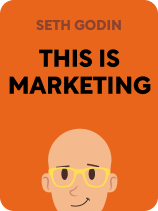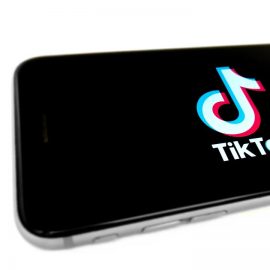

This article is an excerpt from the Shortform book guide to "This Is Marketing" by Seth Godin. Shortform has the world's best summaries and analyses of books you should be reading.
Like this article? Sign up for a free trial here.
Why shouldn’t companies focus on selling? What should they focus on instead? What’s the ultimate goal of marketing?
In his book This Is Marketing, Seth Godin explains why old marketing techniques are no longer effective. He outlines four bedrock principles to help guide successful marketing in the modern age.
Continue reading for an overview of this practical book that can benefit all business leaders.
This Is Marketing (Seth Godin)
Despite what you may believe, being an effective marketer isn’t about being the biggest or the loudest. In This Is Marketing, Seth Godin argues that traditional marketing techniques are no longer effective in today’s media-saturated world. He argues that, instead of focusing on selling, companies should focus on building strong relationships with customers based on trust, authenticity, and empathy. Effective marketing, he explains, is more than convincing someone to buy something; it’s about changing people’s lives.
Godin is an entrepreneur and marketing expert with over 30 years of experience in the industry. He has written more than 20 books on the subject, including All Marketers Are Liars, The Purple Cow, and Tribes. After working as the Vice President of Direct Marketing at Yahoo, Godin left to found Yoyodyne, an online advertising and email marketing company, which was later acquired by Yahoo for $30 million. He has been featured in media outlets such as The New York Times, The Wall Street Journal, and Forbes. In 2018 (the same year that This Is Marketing was published), Godin was inducted into the Marketing Hall of Fame and continues to be known as a leading voice in the marketing industry.
What Is Marketing?
According to Godin, traditional marketing (what he calls interruption marketing) no longer works because it relies on competing for consumers’ attention by spamming them with ads. He argues that in today’s media-saturated landscape, people’s attention has become more valuable because they have so many options to choose from. When people are constantly bombarded by advertisements, they become better at tuning out what doesn’t interest them. In short, he suggests, you can’t trick people into wanting what you’re selling by being the loudest or the biggest. People can just ignore you.
Instead, Godin advocates for what he calls “permission marketing”—intentional marketing to a group of people who want to hear what you have to say. He argues that good marketers consider who they are trying to serve and what they need, and then work diligently to meet that need. With this strategy, marketing is a practice of empathy rather than manipulation and becomes about making a positive change in people’s lives—a change they actually want.
According to Godin, there’s no step-by-step method for effective marketing. Instead, he offers a set of guiding principles: Create something of value, focus on your core audience, match your story to their point of view, capitalize on the power of word of mouth, and be consistent. We’ll explain each principle in more detail.
Principle 1: Create Something of Value
To be an effective marketer, you must first create something of value. Godin explains that many people make the mistake of creating a product and then trying to figure out how to sell it. Effective marketers do the opposite: They identify a group of people with a problem and then provide a solution to that problem.
Godin argues that, to create a product that solves a problem, you should identify an unmet desire or need and make sure that your product addresses it. Godin suggests that people’s needs are often rooted in unmet emotional desires. People don’t buy a product for the product’s sake, but for the feeling the product gives them. For example, no one needs a nose hair trimmer or a new set of headphones. But people do need the self-confidence or social status that those products give them.
Godin suggests that most people, regardless of age, gender, or geography, are driven by the same basic human needs, things like safety, security, belonging, or respect. Godin argues that these desires are universal and apply to people from all walks of life but look different depending on whom you’re speaking to. For one person, security might mean a high-quality life insurance policy, while for another it’s an in-home video surveillance system or a paid-off mortgage. By understanding people’s most basic emotional needs, marketers can create products and services that meet those desires, and, by doing so, offer them a solution to their problem.
Principle 2: Focus on Your Core Audience
But which people are you trying to help? According to Godin, effective marketers don’t try to reach everyone. Instead, they focus on serving a specific group of people well. Godin argues that to be an effective marketer, you need to focus on your core audience, what he describes as your smallest viable market.
According to Godin, your core audience is the smallest group of people who share a common need or desire that can sustain your business or project. Depending on your product or service, your core audience might be coffee lovers passionate about specialty coffee beans or DIY enthusiasts new to woodworking. He explains that by focusing on your niche market, you’ll be able to develop a deeper understanding of your customers’ needs and wants and create products and services that best address those needs. This approach allows you to stand out in a crowded marketplace and build a loyal customer base that will help you grow your business.
Your core audience should be defined by a shared value system (what Godin refers to as their “worldview”) rather than demographic traits. Demographic traits may vary, but shared values transcend those differences and are more influential in driving meaningful connections and engagement. By focusing on shared values, you can create a loyal community based on a strong foundation of shared ideals. For example, an eco-friendly clothing brand may target individuals who prioritize sustainability and environmental consciousness, regardless of their age, gender, or location.
Principle 3: Match Your Story to the Audience’s Point of View
Once you know your core audience, you need to match the story you’re telling to their point of view so they understand that your product or service is for them. Godin explains that our decisions, including decisions about what to buy, are based on the stories we tell ourselves about who we are. For example, “I am the kind of person who…” shops at the local co-op, or uses coupons, or wears a luxury watch. To effectively market to your core audience, make sure that the story you tell aligns with the story your audience tells about themselves.
Use Tools for Alignment
Two of the tools you can use to align your story with your audience’s self-perception are branding and price.
Branding
Godin argues that a brand isn’t merely a logo but the sum of all customer experiences and expectations. He therefore defines a brand as a promise to deliver a specific level of quality, reliability, and value to customers. Although a brand encompasses more than just visual elements, Godin acknowledges branding elements like symbols, fonts, and language still play a significant role. These elements help shape customers’ perceptions and expectations and serve as signals for conveying the brand’s values, personality, and positioning. To establish effective branding, Godin suggests utilizing simple and consistent symbols, language, and colors.
Coca-Cola is an example of a company with simple and consistent branding that has ingrained Coca-Cola in popular culture, establishing instant recognition and positive emotional associations. With its classic red color, logo, and familiar commercials and slogans, Coca-Cola has successfully built a globally recognized brand that symbolizes happiness and shared experiences.
Price
Godin argues that price is also an important part of a marketing story because price can be used to strategically position a product or service in the market. For example, a high price can signal that a product is exclusive and high-quality, while a low price can signal that a product is affordable and accessible. One isn’t better than the other; they just appeal to different audiences. The price you choose should align with the point of view of your audience.
McDonald’s and Gucci both effectively use price as a part of their marketing strategy, albeit differently. McDonald’s emphasizes affordability, targeting a broad consumer base by positioning itself as a budget-friendly choice with a focus on value and convenience. In contrast, Gucci takes a luxury approach, using higher prices to create an exclusive and desirable image associated with prestige, craftsmanship, and indulgence in high-end fashion. McDonald’s appeals to a wider audience with affordable pricing, while Gucci caters to a more selective segment seeking luxury and status. Each brand’s pricing strategy aligns with the self-perception of its target market.
Apply Pressure to Inspire Action
To effectively engage your target audience, it’s important not only to communicate that your product or service is tailored to them but also to inspire them to take action. Whether it’s convincing them to sign up for a newsletter, purchase a new product, or support a candidate, motivating people to act requires applying pressure. This can be achieved by presenting a relatable problem and offering a solution that resolves it. By presenting this combination of problem and resolution, you can motivate your audience to alleviate the pressure they feel by actively engaging with your brand.
One way to apply pressure is to challenge the status or position of your core audience. Godin defines status as an individual’s perceived position or rank within a particular social group or hierarchy.
Godin argues that many of our decisions are driven by the desire to maintain or shift our status, but we do so in different ways. Some people seek to maintain or shift their status through a sense of belonging, while others do it through superiority.
Belonging is about the desire of people to connect with specific groups or communities whose opinions they value. To apply pressure on people who seek belonging, provide opportunities for them to belong. Jones Road Beauty exemplifies a brand that skillfully utilizes the concept of belonging to apply pressure on its customers. By promoting natural beauty and authenticity, Jones Road Beauty taps into individuals’ longing to be part of a community that shares these values. Through inclusive marketing campaigns featuring diverse models and fostering active online community groups, Jones Road Beauty cultivates a sense of inclusivity and creates opportunities to belong.
Superiority, on the other hand, is fueled by people’s desire to differentiate themselves and demonstrate their dominance. Godin writes that to apply pressure to this audience, you need to provide them with opportunities to excel and outperform others. Tesla effectively applies this concept to exert pressure on its customers by showcasing groundbreaking electric vehicles with cutting-edge technology and performance. Their marketing campaigns highlight exceptional features, positioning Tesla as a leader in the electric car industry. This motivates individuals to invest in Tesla vehicles as a means of showcasing their superiority and staying ahead of the curve.
Transform a Culture
Ultimately, the goal of the story you tell is to transform the culture of your core audience because you want what you’re offering to become a part of their cultural norm. When something becomes embedded in a culture, it becomes deeply ingrained in people’s behaviors, beliefs, and values. This cultural integration ensures that your offering isn’t merely seen as a transactional product but rather as an essential and meaningful aspect of their identity and lifestyle.
However, culture does not change all at once. It begins with a few. When you first begin your marketing journey, before anyone has heard of you, your story should focus on the trendsetters (what Godin calls adopters), people who are always looking to try the next new thing because your product is new and no one has tried it before. The story you tell will be about innovation. You need to explain how your product pushes the boundaries of technology or revolutionizes an industry.
As more and more people hear about what you do, your audience will shift from trendsetters to assimilators (what Godin calls adapters), people who tend to follow the crowd. You need to adjust your story accordingly, communicating how what you offer also provides a sense of familiarity and fits seamlessly into your audience’s existing routines.
Principle 4: Capitalize on Word of Mouth
While your initial fans, the trendsetters, appreciate your unique approach, it may not resonate with the wider public. To make the jump to a broader audience, you need a product or service that people want to talk about. Godin explains that the products and services that people will talk about are the ones that become more valuable the more people know about them.
Consider the example of dating apps. Early adopters of dating apps, like Tinder or Bumble, had a reason to talk about the product with other people. More users meant a wider pool of potential matches and increasingly diverse profiles. Additionally, the accumulation of user data allowed apps to refine their matching algorithms, suggesting more accurate and compatible matches. Moreover, the more people that use the apps, the less social stigma there is around using dating apps as a tool of connection.
By creating a product that thrives on word-of-mouth and effectively addresses the needs of your core audience, you can tap into their network power and transform them into invaluable marketing assets. As your core audience witnesses firsthand how your product or service meets their needs, their passion for your company grows, prompting them to voluntarily spread your product’s message to attract more people, all without incurring additional costs.
However, Godin says it’s crucial to consistently fulfill the promises you’ve made and provide effective solutions to the problems you claim to solve. By delivering on your brand promise, you establish trust with your customers, increasing the likelihood of repeat business. This consistency also enables you to cultivate a community and foster a strong brand culture over time. As a result, your customers become your most fervent supporters, advocating for your company’s mission and products.

———End of Preview———
Like what you just read? Read the rest of the world's best book summary and analysis of Seth Godin's "This Is Marketing" at Shortform.
Here's what you'll find in our full This Is Marketing summary:
- Why traditional marketing strategies are no longer effective
- Why you should aim to build trust, authenticity, and empathy with customers
- Guiding principles for successful marketing in the modern age






